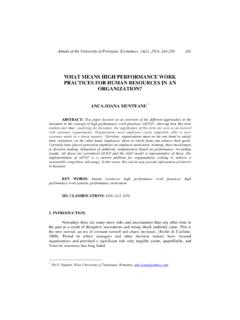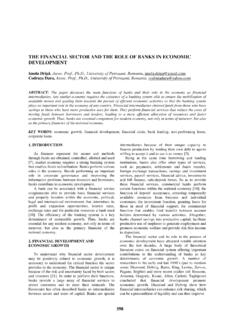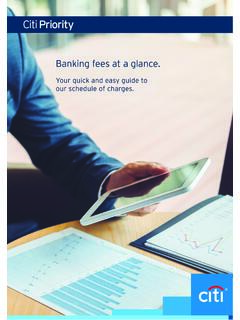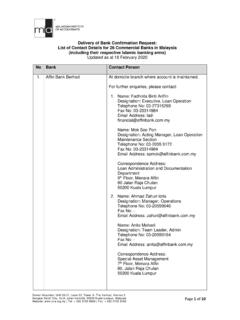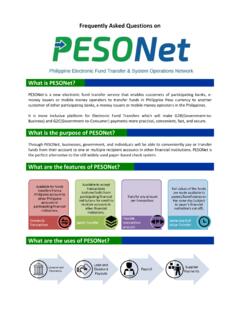Transcription of E-BANKING SERVICES – FEATURES, CHALLENGES AND BENEFITS
1 Annals of the University of Petro ani, Economics, 14(1), 2014, 49-58 49 E-BANKING SERVICES FEATURES, CHALLENGES AND BENEFITS IMOLA DRIG , CLAUDIA ISAC * ABSTRACT: Today traditional banking SERVICES , based on lending and deposit-taking operations, are only part of banking activities. Due to the emergence of a knowledge-based economy and society as information and communication technology advanced, banking SERVICES have undergone profound changes during the past decades. In order to improve the quality of customer service delivery and reduce transaction cost, banks have invested to a great extent in ICT and have adopted ICT networks for delivering a wide range of banking products and SERVICES .
2 Banks all over the world have embraced innovative banking technologies and E-BANKING SERVICES in recent years. In this context, the paper aims to provide an overview of the electronic banking service highlighting various aspects of E-BANKING . Although E-BANKING offers many advantages both to corporate and individual clients, electronic banking is not without certain CHALLENGES and issues in terms of security and interest of customers. KEY WORDS: banking sector, E-BANKING , online banking, mobile banking, PC banking, issues in E-BANKING . JEL CLASSIFICATIONS: G21. 1. INTRODUCTION The banking industry is being reshaped by globalization, competition and innovation and customer needs.
3 Due to the emergence of a knowledge-based economy and society as information and communication technology (ICT) advanced, banking SERVICES have undergone profound changes during the last period. According to Wisdom (2012) ICT, the most important factor in the future development of banking, enables banks to create sophisticated products, to have better market infrastructure and to reach geographically distant and diversified markets. Furthermore, consumers banking needs and demands have changed significantly over * Assoc. Prof., , University of Petro ani, Romania, Assoc. Prof., , University of Petro ani, Romania, 50 Drig , I.
4 ; Isac, C. the past three decade. They require today more personalised banking products and SERVICES and they expect to access such SERVICES at any time and any place. In addition, customers are looking for simplicity in their day-to-day banking and those who trust their bank are more willing to consolidate their banking needs with a single financial SERVICES provider. In recent years the very nature of banking is changing. What used to happen only in branches can now happen anywhere in the world at any time and through any delivery channel a customer might choose (ATMs, telephones, personal computers). Thus, traditional banking network consisting of physical branch infrastructure is more and more threatened by information technologies represented by automated forms of interaction with the client (ATMs, call centres, online banking, mobile banking) that involve relatively lower costs and allow customers to choose from alternate delivery channels (Darlington, 1999).
5 Therefore, the introduction of new technologies have led to significant changes in bank strategies and branch banking started to lose ground to virtual banking as the use of remote banking SERVICES increased. Globalization, competition, changing social trends and especially ICT advancements have caused intense restructuring of the banking industry (Loonam & O Loughlin, 2008). Initially, information infrastructure was regarded by developed banks over the world as a mere possibility of creating new electronic distribution channels for existing products. For this reason, remote banking SERVICES have been called electronic or E-BANKING SERVICES (Nedelescu & St nescu, 2012).
6 Source: PWC, Reinventing Banking Branch Network, December, 2012 Figure 1. Channel strategy In time, the increase of investments in technology was followed by banking products innovation, a driving force of efficiency boost. Banks and information technology manufacturers have begun to stimulate each other more and more in the development and profit creation. The increasing range and complexity of electronic banking SERVICES has led to the expansion of customers while satisfying more sophisticated needs and ensuring customer loyalty imposed a continuous demand for new technologies (Drig , 2012). E-BANKING SERVICES - Features, CHALLENGES and BENEFITS 51 2.
7 E-BANKING - CONCEPTUAL FRAMEWORK Remote banking, considered representative for the new economy, consists of electronic transactions between customers and their bank. Electronic banking, more commonly known as E-BANKING , is the newest delivery channel for banking SERVICES . The term had been defined in many ways by researchers mainly because electronic banking refers to several types of SERVICES through which customers can request information and execute transactions via telephone, digital television, computer or mobile phone. Daniel (1999) defines electronic banking as the distribution of information and SERVICES by banks to customers via different delivery platforms that can be used with a personal computer or other intelligent devices.
8 According to Allen (2001), E-BANKING refers to the supply of information or SERVICES by a bank to its customers, via a computer or television. Keivani et al. (2012) describes electronic banking as an umbrella term for the process by which a customer may perform banking transactions electronically without visiting a brick-and-mortar institution . Most specialists agree that E-BANKING ensures 24-hour-a-day, 7-day-a-week accessibility through a type of advanced information system. A common definition for electronic banking comes from the Basel Committee on Banking Supervision: E-BANKING includes the provision of retail and small value banking products and SERVICES through electronic channels as well as large vale electronic payments and other wholesale banking SERVICES delivered electronically (BCBS, 1998).
9 E-BANKING , a term used for new age banking system, represents an automated delivery of new and traditional banking products and SERVICES directly to customers through electronic, interactive communication channels. It is a service that provides customers the opportunity to gain access to their accounts, execute transactions, and obtain information on financial products and SERVICES through a public or private network, including the Internet. There are several terms used in the literature all referring to one form or another of electronic banking: personal computer (PC) banking, internet banking, virtual banking, online banking, web banking, home banking, phone banking, remote electronic banking, mobile banking etc.
10 , but they are often used interchangeably. Electronic banking SERVICES have been around for quite some time in the form of automatic teller machines and telephone transactions. In more recent years, modern E-BANKING SERVICES such as internet and mobile banking has revolutionized banking SERVICES . The evolution of the E-BANKING industry can be traced to the early 1970s when banks began to look at these types of SERVICES as an alternative to some of their traditional bank functions. First, such a choice was considered appropriate since it ensures reduced costs as branches were very expensive to set up and maintain. Second, E-BANKING products and SERVICES like ATMs and electronic fund transfer were an important qualitative element of differentiation for banks that used them (Mobarek, 2007).
